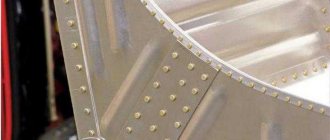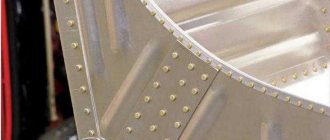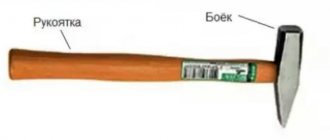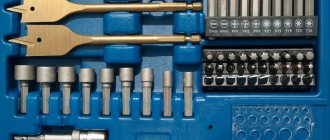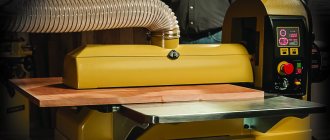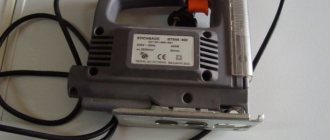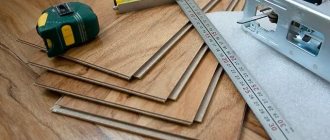When purchasing a jigsaw file at a retail outlet with a salesperson or manager-consultant, it is enough to name the jigsaw model and the material that needs to be cut. A competent salesperson or manager-consultant will select exactly what you need and can give advice on the features of each manufacturer.
When purchasing in a self-service store or online market, the buyer must understand the labeling and quality characteristics of the files themselves. Otherwise, there is a chance of making an unnecessary purchase. Therefore, when buying, you need to know the main points.
Marking files and reading them
The difficulty is that there is no unified labeling system in the world. However, many manufacturers try to adhere to the labeling system used by Bosch. And the main marking elements are the same on many products.
The purpose and compatibility of files is determined by color, as well as by digital and letter markings. Often the markings are applied to the shank of the file. There it is not erased during operation, and it will always be possible to determine what material it is intended for. But sometimes markings are placed throughout the canvas. Then, during work, the markings are erased, and the master will have to remember what kind of file it is. The colors mean the following:
- Gray – only for wood.
- Blue is for metal.
- White – for metal and wood.
- Red - for various plastics.
- Black - universal for many materials, specified by additional marking.
A saw for hard materials can be used to cut softer materials, but never vice versa. That is, a metal file can be used to cut wood, but not vice versa. But for effective cutting, you should select a file that is suitable for the material or a universal file.
Compatibility with the jigsaw in terms of the shank shape is important. The most common is the T-shank. As a rule, all such files have a standard shank size that fits all jigsaws. But sometimes there are models, especially old ones, that use saws with different shanks and their markings:
- U stands for U-Shaped Shank.
- M - straight shank with two holes, found on older Makita models.
- F – two crossbars and a straight end.
For the buyer, this marking letter has little meaning, since the shape of the shank is visible at the first glance at the file, even in a picture on the Internet.
The markings begin with these letters T, U and others. For example T101B.
The first number after the letter indicates the saw length group.
- 1 – the shortest files, up to 75 mm long.
- 2 – files of medium length, from 75 to 90 mm.
- 3 – files of increased length, from 90 to 150 mm.
- 4 are the longest, over 150 mm.
Special files with a length of more than 200 are marked with two numbers (the number) 10. In this case, there is a four-digit marking after the letter.
For sawing different materials, saws with different tooth shapes and sizes are used. tooth The last two digits indicate the shape and size of the tooth and its intended use for a particular material.
- 01 – teeth without set, ground to obtain a clean cut.
- 02 – for cutting various plastics.
- 08 – special tooth shape for the cleanest cut.
- 13 – wave-shaped file for soft materials.
- 11 and 19 – wood saws.
- 23 and 24 – files with different shapes and tooth pitches.
- 27 – files for copper, brass, aluminum.
- 41 – saws for sheet building materials – gas silicate (foam concrete), plasterboard, fiber.
- 44 – large tooth with a large set for fast rough sawing of wood.
These numbers are followed by a letter marking - one of the first four letters of the Latin alphabet - A, B, C, D. It indicates the size of the tooth in four main groups. A – the smallest tooth, further enlarged.
As an example, the marking of the T101B file is deciphered as follows:
- T – T-shaped shank.
- 1 – short file, up to 75 mm long.
- 01 – teeth without set, ground to obtain a clean cut.
- B is the second smallest tooth size.
This is the simplest marking. At the beginning it was said that the meaning of the marking may differ among different manufacturers. For example, if after the numbers there are symbols other than A, B, C, D, then the marking does not indicate the tooth size, but the pitch, that is, the distance between the centers of the teeth. Deciphered according to the following table:
- G is the smallest step, up to 1 mm.
- E - pitch from 1.4 mm to 1.5 mm.
- A - step from 1.5mm to 2mm.
- B from 2 mm to 3 mm.
- BC - marking of different (variable) steps, alternating larger and smaller steps.
- C - from 3mm to 4mm.
- D - from 4 to 5 mm.
- X - files with different tooth pitches, increasing towards the end of the blade
- RIFF is a blade with a special fine-grained coating for cutting ceramic tiles.
In addition, the purpose of the file can be simply indicated by an English word. Specifically:
- Wood - used for regular wood.
- Hardwood - for hard wood.
- Alu - the first letters of the name of the metal - aluminum.
- Metal - for ferrous and other metals.
- Inox - specifically for stainless steel.
- Acrylic - for cutting polycarbonate and acrylate materials.
- Fiber&Plaster - for cutting plastics and fiberglass.
- SoftMaterial - for soft sheet materials (linoleum, artificial leather and leather, polystyrene foam, polystyrene foam, etc.)
Sometimes the inscription is in Russian instead of English. For example, just “wood/plastic”.
The grade of steel from which the file is made is important. If the length, shape of the shank, dimensions and pitch of the teeth can be seen and assessed without markings, simply by examining the file, then the grade of steel can be determined solely by markings.
- HCS is a steel with a high carbon content, suitable for cutting soft materials.
- BiM—bimetal (two metals). The use of two different metals increases the strength of the canvas. Bimetal blade can be used for different materials.
- CV is an alloy of chromium and vanadium.
- HSS (high-speed cutter) is the most common tool cutting steel. Used for cutting metal.
- Carbide Technology (CT) or NM - files with a super-hard coating of tungsten carbide, cobalt or artificial diamond powder. They can cut ceramic tiles, finishing bricks, various plastics, asbestos-cement sheets, slate and many other materials.
The metal mark is applied separately from the rest of the markings. Most often, also on the shank, located perpendicular to the rest of the markings.
Files from Rebir and their compliance with expensive analogues from Bosch.
Classification by type of material processed
The modern market offers a large selection of different saws for sawing the same material. They differ in length, shape and size of the tooth, pitch and metal from which they are made. But they belong to the same group, for example, “wood saws”.
We also recommend reading an interesting article on how to choose a jigsaw; it contains 9 best tips from an expert that will help you make the right choice.
Tree
For this material, you can choose a file with a length from 75 mm to 150 mm.
As a rule, they are all labeled with the word Wood (wood) or Hardwood (hard, hard wood). Different types of files are selected for different tasks.
- A saw with large, sparse teeth, up to 6 mm, will provide a quick rough cut.
- A cleaner cut is made with saws with teeth of about 3 mm.
- For curly cutting along curved lines, a narrow file with a fine tooth, about 2 mm, is suitable.
Laminate
For sawing various laminates, saw blades are selected according to the same principle as for wood. The only difference is that the file must have a medium or fine tooth, designed for laminate, or be universal (wood/plastic).
Metal
An electric jigsaw is rarely used for cutting metal. There are cutting methods that are much more efficient (angle grinders with cutting wheels for metal, hand jigsaws with long files, gas cutters, etc.). However, in some cases it is rational to use a jigsaw with a suitable file.
For example, a long cut with a complex curvilinear shape (rounds and circles, sharp triangles, etc.) cannot be made with a cutting wheel and a hand jigsaw. It is not recommended to use a jigsaw to cut metal thicker than 3 mm, especially black.
Metal files are marked Alu for soft metals or Metal for ferrous metals, galvanized and stainless steel.
Steel grade – high-speed cutter HSS or bimetal BiM.
Plastic
The plastic is sawed off by turning off the pendulum stroke. Files with small and medium teeth of short length are used. Fiber&Plaster marking. For certain types of plastic (PVC), files for hard wood (Hardwood), or universal ones with the inscription “wood/plastic” in Russian or English, are sometimes well suited.
Glass
It is impossible to cut ordinary glass with saws. For this, glass cutters with a diamond wheel are used. You can use saws to cut plexiglass, which is a transparent type of plastic. They also cut it with the same files as plastics (see above).
Ceramics
Ceramics are hard and brittle materials. To cut it, special saw blades with a carbide coating are used, which is much stronger than ceramics. Most often it is tungsten carbide or artificial diamond powder. The file itself is made of ordinary tool steel. The marking of such files is Carbide Technology (CT) or NM. The blade is smooth, without teeth.
Soft materials
Universal and special files are suitable for such materials. The first ones should be tried in practice during practical cutting. Rubber, paper and other materials are cut completely differently. Special files are made specifically for a specific material. They can have teeth or be wavy (for cardboard, foam, rubber, etc.). Suitable files may be labeled SoftMaterial or Acrylic.
Universal
There are no absolutely universal files “for all materials”. But often the same files can be used to cut different materials with different densities, structures, viscosities and strengths.
For example, a metal saw can cut wood and plastic. In this case, the file may get stuck in rubber or linoleum due to strong friction and sawdust sticking in the slot . Therefore, the selection of saw blades, even if they are positioned by sellers and manufacturers as universal, is only possible with trial cuts.
Files are often sold in a set that includes files for a variety of materials. This is convenient for users.
- Firstly , there is no need to look separately for special files for different materials.
- Secondly , it is possible to try how the saws will cut different materials. For example, a saw for metal – wood.
TOP 10 best inexpensive and budget jigsaws 2020-2021 for the home
Our rating includes inexpensive models with good functionality and high technical performance.
Makita 4329 450 W
Compact and easy to use, Makita 4329 is good for everyday use. It has an ergonomic handle shape, comfortable and practical.
Specifications:
| Power, W | 450 |
| Blade movement frequency, strokes/min | 500 — 3100 |
| Saw stroke, mm | 18 |
| Depth of wood cut, mm | 65 |
| Metal cut depth, mm | 6 |
| Pendulum stroke | Eat |
| Speed adjustment | Eat |
| Weight, kg | 1,9 |
| Network cable length, m | 2 |
The tool allows you to make straight and curved cuts in wood. The adjustable frequency of movement of the saw and the presence of a pendulum mode will ensure high productivity both when working with wood and metal.
The sole is made of cast steel. The handle has rubberized lining, a comfortable shape and fits perfectly in the hand. There is a start button on the handle, and there is a locking function for long-term work. The operator is reliably protected by a durable transparent casing.
You can connect a vacuum cleaner to the Makita 4329 jigsaw to collect debris.
| pros | Minuses |
| Excellent build quality | The need to calibrate the blade at an angle of 90⁰ |
| Weak vibration | No storage case |
| Light weight | Short network cable |
| Low cost |
BOSCH PST 700 E 500 W
High-quality tool for precision cutting. Ease of use and reliability.
Specifications:
| Power, W | 500/300 |
| Blade movement frequency, strokes/min | 500 — 3100 |
| Saw stroke, mm | 20 |
| Depth of wood cut, mm | 70 |
| Metal cut depth, mm | 10 |
| Pendulum stroke | No |
| Speed adjustment | Eat |
| Weight, kg | 1,7 |
| Network cable length, m | 3 |
It has a soft start function and is equipped with a vibration-absorbing system, which makes the technician’s work comfortable. The speed of the saw blade is controlled by pressing the start button. It is possible to lock in the working position for long-term operation, but only at maximum speed!
A clean cut, speed and ease of changing saw blades will be a definite advantage. The jigsaw has an adapter for connecting a vacuum cleaner, as well as the function of blowing sawdust and construction debris from the cutting line. Light weight of 1.7 kg will also be a plus.
| pros | Minuses |
| Smooth start | No pendulum motion of the saw |
| Weak vibration | One file included, for better cutting you need to buy more |
| Light weight | No backlight |
| Storage case |
DeWALT DWE349 650 W
Powerful and uncompromising. Can handle hard wood and metal of varying thicknesses.
Specifications:
| Power, W | 650 |
| Blade movement frequency, strokes/min | 500 — 3200 |
| Saw stroke, mm | 20 |
| Depth of wood cut, mm | 80 |
| Metal cut depth, mm | 10 (aluminum - 20) |
| Pendulum stroke | Eat |
| Speed adjustment | Eat |
| Weight, kg | 2,4 |
| Network cable length, m | 4 |
The DeWALT DWE349 jigsaw has proven itself to be a tool with high technical characteristics. With a power of 650 W, it easily copes with hard wood. The thick steel sole is firmly attached to the work surface. This is a reliable assistant in the household.
The handle has a thoughtful shape and a rubberized anti-slip surface. Sawdust and other debris from the cutting line will be blown away by a powerful air stream emanating from the tool. The cable length allows you to work without an extension cord.
| pros | Minuses |
| High power | No case |
| Clean cut | No backlight |
| Long cable | Weight |
BISON L-400 400 W
Lightweight and easy to use, the tool is not designed to perform complex tasks, but in everyday conditions it reliably performs its function.
Specifications:
| Power, W | 400 |
| Blade movement frequency, strokes/min | 500 — 3000 |
| Saw stroke, mm | 18 |
| Depth of wood cut, mm | 55 |
| Metal cut depth, mm | 6 (non-ferrous metal - 10) |
| Pendulum stroke | No |
| Speed adjustment | Eat |
| Weight, kg | 1,4 |
| Network cable length, m | 2 |
One of the lightest electric jigsaw options for the home. The tool has low vibration, convenient adjustment of the frequency of saw movement and fixation if necessary. Even long work will not tire you.
The sole is adjustable by 45⁰, it is possible to install a guide stop. There is a protective glass for safe use.
With fairly low power and the absence of a pendulum stroke, you should not cut hardwood or thick-walled metal, but the ZUBR L-400 jigsaw copes well with simple tasks.
| pros | Minuses |
| A light weight | No pendulum motion |
| Low cost | Short cable |
| Lots of plastic parts | |
| No case |
Interskol MP-55/500E 500 W
Quiet tool with smooth start and low vibration. Excellent price-quality ratio.
Specifications:
| Power, W | 500 |
| Blade movement frequency, strokes/min | 800 — 3000 |
| Saw stroke, mm | 18 |
| Depth of wood cut, mm | 55 |
| Metal cut depth, mm | 6 (non-ferrous metal - 10) |
| Pendulum stroke | Eat |
| Speed adjustment | Eat |
| Weight, kg | 1,6 |
| Network cable length, m | 4 |
Powerful and reliable engine. The jigsaw is equipped with a platform rotation mechanism for cutting at an angle. The design provides protection for the engine from overheating.
The set includes a guide ruler and a pipe for connecting a vacuum cleaner. Soft and long wire, hand protection with a folding visor.
The cutting line is clear, it is possible to adjust the stroke rate and lock the button in the active position. The handle is rubberized, the device itself is quite light, comfortable to hold in the hand.
| pros | Minuses |
| Smooth cut | Uneven platform base |
| A light weight | Protective glass blocks your view when cutting |
| Low cost | No airflow to the cutting line |
| No case |
Fiolent PM 5-750E M 750 W
Powerful and practical electric jigsaw with molded base. The choice of experienced businessmen with knowledge of carpentry.
Fiolent even comes with a parallel stop, a sole and an adapter for connecting a vacuum cleaner as standard.
Specifications:
| Power, W | 750 |
| Blade movement frequency, strokes/min | 2800 |
| Saw stroke, mm | 26 |
| Depth of wood cut, mm | 135 |
| Metal cut depth, mm | 10 (aluminum - 20) |
| Pendulum stroke | Eat |
| Speed adjustment | Eat |
| Weight, kg | 2.4 |
| Network cable length, m | 3 |
Fiolent PM 5-750E M has excellent characteristics for a household jigsaw. Great capabilities for cutting wood, steel and non-ferrous metal, a clear cut with good power - all this allows you to perform a wide range of work on wood and metal, and carry out jewelry work.
Well equipped: parallel stop, soleplate, adapter for connecting a vacuum cleaner, storage case.
This model has practically no flaws, but the file is offset to the right and is not centered. Perhaps this nuance was intended by the manufacturer as a technical necessity, but, according to users, in some cases it is necessary to correct it with a file.
| pros | Minuses |
| High power | Blade offset to the right |
| Build quality | Weight |
| Reliability, service life | No backlight |
| Smooth and clean cut | |
| Availability of a storage case |
Metabo STEB 65 Quick box 450 W
A reliable manufacturer guarantees the high quality of its products. Metabo power tools have traditionally received high praise from customers all over the world.
Specifications:
| Power, W | 450 |
| Blade movement frequency, strokes/min | 600 — 3000 |
| Saw stroke, mm | 18 |
| Depth of wood cut, mm | 65 |
| Metal cut depth, mm | 6 (non-ferrous metal - 18) |
| Pendulum stroke | Eat |
| Speed adjustment | Eat |
| Weight, kg | 1,9 |
| Network cable length, m | 2,5 |
The wide functionality of this model allows you to perform most household jobs. High-quality and smooth cut. The rubberized, staple-shaped handle fits well in the hand. There is a protective glass, which however may block part of the view.
Sawdust is blown away and a vacuum cleaner can be connected.
Many craftsmen, after purchasing, complain about the fact that the file moves to the left when sawing. In this case, you should pay attention to 2 points:
- The quality of the file. It may be worth purchasing a file from a different brand;
- Thickness of the canvas. The T344DP blade works well, but the T344D we use is too thin.
| pros | Minuses |
| Clean cut | Offset cutting line to the left |
| Low vibration | No backlight |
| Quick-release fastening of the file | No case |
Kolner KJS 480 480 W
The most budget model in our selection. Of course, you shouldn’t expect record performance from a jigsaw that costs a thousand rubles. However, he copes well with the main tasks of a home-loving owner.
Specifications:
| Power, W | 480 |
| Blade movement frequency, strokes/min | 3000 |
| Saw stroke, mm | 18 |
| Depth of wood cut, mm | 55 |
| Metal cut depth, mm | 6 |
| Pendulum stroke | No |
| Speed adjustment | No |
| Weight, kg | 1,4 |
| Network cable length, m | 2 |
Basic model of a jigsaw. It does not have a pendulum stroke or adjustment of the frequency of movement of the saw. Average power ratings do not allow working with hardwood or metal more than 6 mm thick. The inhabitants chose this model for its low cost and the ability to perform simple household tasks.
Kolner KJS 480 in the basic configuration has spare carbon brushes, a wood file, a metal file, and a hex key.
| pros | Minuses |
| Price | No pendulum motion |
| A light weight | Lack of speed control |
| Strong vibration | |
| No backlight | |
| Length of cable |
BLACK+DECKER BES610 650 W
A good tool, time-tested. Metallized coating, powerful engine - a dream, not a tool.
Specifications:
| Power, W | 650 |
| Blade movement frequency, strokes/min | 1000-3100 |
| Saw stroke, mm | 18 |
| Depth of wood cut, mm | 90 |
| Metal cut depth, mm | 8 (aluminum - 15) |
| Pendulum stroke | Eat |
| Speed adjustment | Eat |
| Weight, kg | 2,2 |
| Network cable length, m | 2,5 |
Rich functionality. Works equally well on both wood and metal. Clean, flawless cut.
Quick-release fastening of the file, molded sole, ergonomic, soft handle, removable adapter for connecting a vacuum cleaner.
The model has many advantages among instruments of a similar level.
| pros | Minuses |
| Build quality | Standard saw blade |
| Reliability, service life | Strong vibration |
| Cleanliness of cut | No backlight |
| No case (can be purchased separately) |
PATRIOT LS 650 2021 570 W
A tool worth checking out. Inexpensive but powerful. It has all the necessary functions, including backlighting, which is sometimes one of the key selection criteria for buyers.
Specifications:
| Power, W | 570 |
| Blade movement frequency, strokes/min | 800 -3000 |
| Saw stroke, mm | 17 |
| Depth of wood cut, mm | 65 |
| Metal cut depth, mm | 8 (aluminum - 10) |
| Pendulum stroke | Eat |
| Speed adjustment | Eat |
| Weight, kg | 1,9 |
| Network cable length, m | 2 |
The jigsaw is powerful and copes well with hard wood and steel. Has 5 travel speeds.
There is airflow to the cutting surface and there is protective glass. The glass may interfere with visibility; it can be removed. A staple-shaped rubberized handle, a relatively light weight of the jigsaw, low vibration - everything for comfortable long-term work.
There are two modifications of this model, going under a common name. They differ in how they fasten the blade, which significantly affects the quality of the cut. The model with an eccentric fastening is rated as allowing for errors in the evenness of the cut; the model with a quick-release fastening has only positive reviews. Be careful when purchasing!
| pros | Minuses |
| Build quality | Possibility of not guessing with modification |
| Reliability, service life | No case |
| Availability of backlight | Short cable |
| Price |
Varieties of cutting edge geometry
All files differ in the size of the teeth, the pitch between them and the setting (deviation in different directions).
Milled, classic layout
These are teeth cut out on the canvas by milling with a regular set. One tooth is deviated to the left, the next to the right, etc.
It is called classic or traditional because the teeth on all hand saws, two-handed and sawmill saws, etc. are set in exactly the same way.
With this cut, the cut is wider than the blade. Therefore, clamps are eliminated, sawing is easier, and sawdust ejection is easier.
Milled, wavy layout
It also provides a wider cut than the blade, just like a classic routing. The difference is that the deviation in different directions is not just one for each tooth, but wave-like for several. “Waves” enter the material more smoothly, with less resistance.
Files with wavy layout are used for clean cuts on laminated chipboard, MDF, as well as for cutting metals.
Polished, classic layout
The geometry of the teeth of such files is the same as that of the milled ones described above. The difference is that after cutting and setting, the teeth undergo grinding, during which they are sharpened and acquire a smooth surface. Due to this, friction is reduced and sawing is accelerated, the cut is cleaner, and there are fewer chips of the material.
Conical grinding, without routing
The file has an even row of polished, sharpened teeth. In this case, the shape of the teeth is such that the cut is slightly wider than the blade and without setting. Provide precise, even and neat cuts on various materials.
The main parameters of canvases and what do they affect?
All main parameters are described above. Briefly about what determines each of the main parameters.
Shank types
The shape of the shank must match the model; for example, a file with a U-shaped shank cannot be mounted in a jigsaw designed for T-shaped files.
Sometimes it happens that thick files with a suitable shank do not fit into the fastening groove. This occurs on models with an auto-clamp (without threaded fastening). In such cases, take a thinner file, or slightly sharpen the shank on both sides.
Dimensions
The length of the files is divided into 4 groups from 75 to 150 mm. Each group is marked in the marking with a number from 1 to 4. When selecting the length of the file, proceed from the thickness of the material. At maximum reach, the end of the file should come out of the workpiece.
The longer the file, the more prone it is to move to the side. As a result, the cut may end up crooked. Short, thick files are less prone to bending and cut more accurately.
Saw blades of maximum length - 100-150 mm are used for cutting large-sized wood, soft and light materials such as polystyrene foam.
Tooth shape
Most teeth are shaped like a triangle with sharp corners. Their sizes, layout, and inclination may be different. In addition, there are blades with a wave-shaped cutting edge for soft materials and blades without teeth, with super-hard coating for ceramics, bricks and other hard materials. Here, a layer of diamond chips or tungsten carbide acts as a cutting surface.
Main selection criteria
If you have already decided on the type of device, the design of the saw blade fastening mechanism and the shape of the body, then the next step is to study the technical characteristics.
Power type
Today, jigsaws are widely represented on the domestic power tools market in two power supply options:
- Wired, operate from a household network 200 V/50 Hz;
- From a battery with a voltage of 10.8 V, 12 V, 14.4 V, 18 V and a capacity of 1-4 Ah.
Mains power Cordless jigsaw
When choosing a wired model, always pay attention to the length, cross-section of the cable and the quality of its insulation. If you need autonomy, then purchase cordless jigsaws. However, do not forget that wireless models have much more disadvantages than advantages. The main disadvantage is the limited operating time of the tool on one battery charge.
Power consumption
The capabilities of any electric jigsaw are largely limited by the power of its power unit. The power of devices available for sale today can vary in the range from 350 W to 1 kW:
- A device with a power of 350-400 W can cope with wooden workpieces with a thickness of no more than 65 mm and steel sheets of 2 mm;
- For cutting plywood, fiberboard sheets, MDF, chipboard, plastic, 32 mm thick, metal, 4-5 mm thick, a device with a power of 400-500 W is sufficient;
- A device with a power of 600-750 W can cope with a wooden workpiece 85 mm thick and a sheet of metal up to 8 mm.
Saw stroke
This parameter affects the performance of the jigsaw:
- The value from 15 to 26 mm is the maximum possible stroke of the saw blade;
- A short stroke of 15-17 mm for a tool with low productivity, which, by the way, is quite enough for work in a home workshop;
- A tool with a saw blade stroke of 19-26 mm has high productivity and will be useful in the process of regular production of cabinet furniture or procurement operations on a construction site.
File material
Depending on the purpose, saw blades can be made from:
- Carbon steel. Used for sawing workpieces made of soft wood and artificial materials;
- High speed steel. Used for cutting sheet steel and non-ferrous metals;
- Bimetal. They have an increased resource, tolerate overheating well;
- Diamond coated steel. Used for cutting glass and ceramic tiles.
Jigsaw blade materials
File tail shape
Today, the most common type of saw blade shank for electric jigsaws are:
- T-shaped with one stop (cross). Suitable for most modern models of jigsaws from brands such as AEG, Bosch, Makita, Metabo, Hitachi, De Walt, etc.;
- T-shaped with two stops, used in older Bosch models;
- U-shaped (circle-shaped notch). Files with this shank shape are suitable for all types of jigsaws with a screw or collet clamp;
- L-shaped, used only for Peugeot jigsaws;
- Straight with two holes, used in older Makita models.
Types of saw shanks
engine's type
In modern models of electric jigsaws, two types of motors are used:
- open;
- closed.
When choosing a model for your home, pay attention to devices with a closed motor design. The open type of engine is susceptible to dust, which clogs the armature, which adversely affects the operation of the tool.
Maximum stroke rate
For a knowledgeable person, the stroke frequency of the rod characterizes the quality of the cut and the operating speed of the tool. For most models, this parameter varies in the range from 2500 to 3700 strokes/min. The stroke frequency of the rod for the most popular jigsaws is in the range of 3000-3200 strokes/min.
Cutting depth
The depth of the cut depends on the power of the jigsaw, the type of saw blade and the type of material being processed. Manufacturers in the jigsaw documentation indicate several values for the permissible cutting depth: for wood, aluminum and steel.
The depth of cut depends on the power, type of saw blade and type of material
For devices belonging to the class of household tools, this parameter is in the range of 40-160 mm for sawing wood and 5-10 mm for non-ferrous metals.
Presence of a pendulum
All modern models of jigsaws are equipped with a pendulum stroke. The presence of a pendulum, or, as it is popularly called, a “swing,” allows you to significantly increase the sawing speed, often at the expense of reducing the quality of the cut. It is necessary to “swing” the blade when it is necessary to cut a large volume of wooden blanks. In other words, when speed is important, not cleanliness and precision of the cut.
Pendulum stroke
Speed adjustment
Many models have the ability to adjust the engine speed and, accordingly, the stroke of the rod. This useful feature allows the operator to process materials of different densities and viscosities with the highest quality. The harder the material, the lower the speed of the saw blade should be. Wood requires maximum speed, metal requires minimum.
Depending on the design, adjusting the speed of the jigsaw motor for different models of jigsaws can be done in two ways:
- The required speed is set with a special switch before starting work;
- The speed of the saw blade is adjusted during operation by pressing the start button.
If you often have to cut various materials, then you should pay attention to a device with speed control. For continuous work with the bottom material, this function is not mandatory.
Method of fastening the canvas
The design of the fixation mechanism assumes the use of the following as the main fastening element:
- screws;
- clamping device.
The screws allow you to secure files with any shank configuration, but require a screwdriver or hex socket wrench. The clamping device is designed to hold specific saw blades, but does not require a tool. What type of instrument you choose is a matter of taste and the availability of the necessary consumables.
Ease of use
What else should you pay attention to when choosing a jigsaw? On options that determine the convenience of regular use of the device:
- Handle shape: C-shaped greatly simplifies straight cutting of material in a horizontal plane. Mushroom-shaped allows you to better perform figured cuts and sawing material at an oblique angle;
- The presence of a case allows you to keep the instrument in order. This is especially important if it needs to be transported regularly;
- Device weight. Most models weigh between 1 and 3 kg. The mass of the device exerts pressure on the material being processed, subjecting it to deformation. Based on this, to work with thin sheets of fiberboard, metal or plastic, you need to choose a device with a mass of 1-1.5 kg. To work with thick material, pay attention to models weighing from 1.5 to 3 kg.
How to choose a canvas for a specific task
The file is selected taking into account all the markings described above. (Wood – tree, etc.).
A few more basic rules:
- A short, thick file bends less and moves less to the side.
- A large tooth cuts faster, but rougher.
- A small tooth will tear the surface less.
In addition, to make selection easier, manufacturers sometimes put additional verbal markings on the files:
- basic – basic, standard files,
- speed – speed, fast rough cut,
- clean – thin clean cut,
- progressor - files with floating teeth of different sizes, most often universal,
- flexible – wavy layout for sawing metal,
- special – blades with super-hard coating without teeth for ceramics, some types of plastic, etc.
Which file to choose for a jigsaw table top
Countertops made of laminated chipboard and MDF are sawed with saws of sufficient length to cut, but not longer. Long files tend to move to the side. Fine tooth files are used for hard wood (Hardwood) or metal (Alu, Metal).
For quick rough cuts, saw blades with additional speed markings are suitable. A more accurate cut can be made with basic (basic standard) and clean (thin cut) files.
Depending on the characteristics of the material and the jigsaw itself, files can perform differently in their work. A more accurate selection of saw blades is carried out by making trial cuts on an unnecessary piece of material.
For wood
For wood, saws marked Wood (wood) and Hardwood (hard wood) are used. Files with large teeth will provide a quick, rough cut, while files with fine teeth will provide a cleaner and more precise cut.
In some cases, wood is effectively sawed using soft and ferrous metal saws. It is better to cut thick wood with long saws with large teeth. For example, with the marking T344C.
For sawing laminate
To avoid chipping surfaces, use fine-tooth files. When sawing, the pendulum motion is turned off. The difficulty is that laminated sheets or slabs are heterogeneous and consist of pressed sawdust, shavings, wood, plywood, coated with laminite.
Laminate is plastic, the base is fiberboard or MDF, in the case of parquet, wood. Therefore, different files are used, including for wood, plastic, soft and ferrous metal. The most effective option is selected by trial sawing on a piece of material.
For figure sawing on wood
For figured cutting, narrow blades with fine teeth are used. The narrow blade allows you to make turns while sawing without breaking, bending or jamming the blade. The fine tooth makes a precise cut and also does not interfere with the rotation of the file when sawing.
For cutting drywall
Drywall, despite its loose structure, is an abrasive material. That is, it is able to quickly grind down the teeth of a saw, for example, on wood. Therefore, special files with a hard coating, straight or wavy, are used for it. As a last resort, files for ferrous metal, but they will not last long, since the plaster quickly wears off the teeth.
For sawing chipboard
For sawing chipboard, short saw blades (up to 75 mm) with a medium tooth (pitch 2-3 mm, marked A or B) are used. Chipboard consists of sawdust and shavings that can easily be cut through by regular wood or hardwood saws.
However, the resins used to glue them together can be harsh, causing the files to wear out quickly. Therefore, for chipboard saws, the quality of the steel is important. Better if it's HSS.
For figured cutting of chipboard, narrow files with a medium tooth are used. For example, T101VO.
For sawing plywood
Plywood can be sawed with wood saws with medium and fine teeth. A large tooth (for quick cutting) tears out pieces of plywood and saws with noise and vibration of the sheet. In practice, plywood is also sawed with fine-tooth metal files. This gives a high-quality, even cut.
Disadvantages: sawing with such files is slower and they can overheat during operation due to friction; clamps are possible due to a small gap. Severe overheating should not be allowed, as this will cause the material to turn black (burn), and the metal of the file may loosen (lose its hardening).
The best 5 jigsaws for cutting out plywood - our rating of lightweight models
For precision work, you first need a jigsaw that is light and has a high-quality, even cut. There is no need for a pendulum or power above 450 W. In our rating today, we will look at the 5 most convenient, luxurious, high-quality jigsaws for fine work, such as cutting out plywood and other fine work on wood and metal. It’s impossible to count how many jigsaws we have sold, but Makitov’s are ahead of the rest, followed by Boshev’s.
The most interesting thing is this: low-power professional jigsaws cost the same as sophisticated household Chinese models. That is, for 5,000 rubles we can buy a low-power Makita jigsaw or a super-sophisticated, powerful and heavy Chinese one for “cutting wood.” There is no talk of any accuracy here. Therefore, in this selection there are only models that are super lightweight and easy to use with one hand. Go…
Makita 4326
A classic of the genre for precision work, I have three friends who cut all sorts of “openwork” out of plywood, and I sold this jigsaw to all three of them. The reviews are rave. Please note - there is no speed control, no pendulum action and the power is only 450 W, which is why it is so cheap. Of the professional low-power models, it is the best in terms of price and quality. Ideal for sawing plywood, chipboard and boards no thicker than 20 mm. Weighs only 1.9 kg.
If you need a more universal one, then look at model 4329 - the power is the same, but there is speed control and a pendulum. But the price tag is one and a half times more expensive. Therefore, 4326 is the sole leader among jigsaws for precision work. The engine has a smooth running, low noise, high cutting precision and you can work without a break for up to 2 hours (personally tested) - it works like a clock. It's a Makita after all! Thing!
Bosch GST 65 B
The second leader in sales and in the popularity rating of “sawing machines” is this model from Bosch, the blue one is professional. This one is even more “delicate” - the power is 400 W, there is no pendulum and speed control; for its purpose it does not need these options. Super-light - weighs only 1.7 kg! What does he need for precision work? That's right - blowing sawdust and the ability to connect a vacuum cleaner, since they often use it indoors. In addition to plywood, fiberboard and chipboard, they can also work on thin wood; the stated cutting depth for wood is 65 mm. But from personal experience, sawing such boards and bars without a pendulum means “setting down” and “working out” the tool. This jigsaw is for precision work, and sometimes you can use it to cut through a couple of boards if you use a hacksaw to break it in)) A most gorgeous thing, I highly recommend it!
In theory, it was already possible to stop, since these 2 models are the most luxurious. But since the price tag here is about 4-5k rubles, then we will next consider cheaper options from household brands. True, I’ll say right away that they will lose in the softness of the engine and the accuracy of the cut. The differences are, of course, minimal, but they are there.
Bosch PST 700 E
If you need a high-quality household tool, then there is nothing better than a green Bosch - fact! There is only one model with a power of 500 W, without a pendulum, but there is already a stroke adjustment by pressing a button. This model is already more universal; people use it not only to saw plywood, but also to cut thicker boards and even metal. A sort of home station wagon with little power. Such models are called “compact”.
It can blow away sawdust (the switch is on the side), you can connect a vacuum cleaner, it has an anti-vibration system - it’s just super, it’s quite suitable for our needs. And the price tag is about 3,200 rubles, which is almost 2k rubles cheaper than the blue Bosch and Makita. So - as a very good option, the quality here is at its best. By the way, the jigsaw is sold in a convenient suitcase, which is also an awesome plus!
Skil 4181 LA
The lightest in its class - weighing only 1.4 kg! Power 380 W - sufficient for sawing plywood and sheet materials made of wood. Sometimes it is possible to saw thin boards, because the stated cutting depth for wood is 55 mm. If you are just starting your hobby and don’t want to spend a lot of money on a professional tool, then I highly recommend paying attention to the Skill brand.
Their jigsaws were sold a lot; they work for a long time and reliably, of course, if they are used correctly. For example, if you cut 40-50 mm boards with this model, then it will not last long, since the power here is only 380 W and there is no pendulum. This jigsaw is purely for cutting, fortunately it has everything you need - blowing away sawdust, connecting a vacuum cleaner. And the price is only 1800 rubles!
Black & Decker KS500
Well, let’s complete our rating with another high-quality model from a popular household brand. We also sold a lot of Black Dekkers, all of them jigsaws with low power, but precise cutting and pleasant engine operation. This model has a power of 400 W, there is no pendulum and there is no speed control either. So it’s only for sawing thin wood, or, alternatively, for sawing all sorts of carved things out of plywood. Sold in a convenient case (plus) and the price is quite affordable - about 2400 rubles. For indoor work, you can connect a vacuum cleaner, there is a sawdust blowing function. So having glasses is a must!
An excellent jigsaw for home and garden use; the cutting depth is stated to be 60 mm.
But since there is no pendulum, cutting such a thick tree is often not recommended. His element is carving and thin boards. Lightweight and comfortable to use jigsaw. Well, Dekker gives a 2-year warranty, which is also nice. We have sold enough Black Dekkers to be convinced of the good quality of their instruments. So yes, we recommend it. Another note: What kind of beast is this - a corded screwdriver, differences from a cordless one.
Rating of the best files for electric jigsaws
Manufacturers of jigsaws are interested in ensuring that their tools work efficiently. Therefore, many brands themselves produce files for electric jigsaws. Moreover, they are suitable not only for the instruments of these brands, but also for others.
Makita and Bosch are considered leaders in quality. In terms of sales and popularity on Yandex.market and other platforms, Makita is the leader. Bosh is in 3-4th positions. But not because of worse quality, but because of a significantly higher price. If a set of 5 files from Makita can be bought for 380-400 rubles, then Bosch files cost from 600 rubles.
Original Bosch files are of high quality.
Hammerflex files are also popular.
The best manufacturers
As usual, the leaders in quality are such global manufacturers as Makita, BOSCH and Metabo. But their price is also high, sometimes differing from cheaper and less well-known analogues by 2-2.5 times.
The most popular tools for home use remain the tools of key market players, such as DeWALT, ZUBR, Interskol, Kolner, BLACK+DECKER, PATRIOT, Bort.
Household jigsaws from Fiolent have proven themselves to be quite good. They are famous for their even cut, good performance and affordable price. The downside is the quality of the components. Lots of marriage.
What should you pay attention to first?
The shank must fit the specific tool. If in doubt, you can take the original file that was included in the sales package and visually compare it with what you are supposed to buy.
There must be compliance with the upcoming tasks. The file is selected for the required material and the required length.
When purchasing branded files (Makita, Bosch), it is important to avoid counterfeit products. Unfortunately, when buying in absentia, only a low price can indicate a counterfeit, and not always.
Poor quality is revealed upon closer inspection and operation. A counterfeit product may have unevenly milled or set teeth. Or they are separated only in one direction. The surface of the files is rough, the location and colors of the markings are different.
The quality of steel can only be assessed during operation - weak steel does not cut well.
